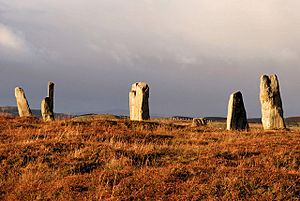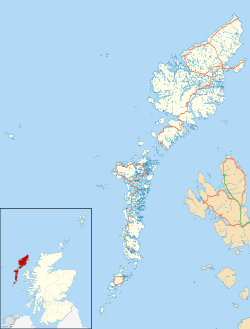Callanish III facts for kids
|
Cnoc Filibhir Bheag
|
|

Callanish III
|
|
| Location | Lewis |
|---|---|
| Coordinates | 58°11′44″N 6°43′27″W / 58.19555°N 6.72416°W |
| Type | Stone circle |
| History | |
| Periods | Neolithic, Bronze Age |
The Callanish III stone circle is a fascinating ancient monument. It is also known by its Scottish Gaelic name, Cnoc Fillibhir Bheag. This stone circle is one of many megalithic structures found near the more famous and much larger Calanais I site. You can find it on the west coast of the Isle of Lewis in the Outer Hebrides, Scotland. These stones were put in place a very long time ago, during the New Stone Age and Bronze Age.
Contents
What is Callanish III?
Callanish III is a special type of stone circle made of two oval shapes, one inside the other. Imagine two giant, slightly squashed rings of stones!
The Outer Stone Ring
The outer ring of stones is about 13.7 metres (45 feet) long and 13.1 metres (43 feet) wide. It originally had 13 large stones. Today, eight of these stones are still standing upright, just as they were placed thousands of years ago. The other five stones have fallen over time.
The Inner Stone Ring
Inside the outer ring, there is a smaller, more noticeable oval shape. This inner ring measures about 10.5 metres (34.5 feet) long and 6.6 metres (21.5 feet) wide. Only four stones remain in this inner circle. The tallest stone here stands impressively at 2.1 metres (almost 7 feet) tall! Unlike some other ancient sites, there is no sign of a central mound or pile of stones (called a cairn) at Callanish III.
Nearby Stone Circles
Callanish III is not alone. It is only a few hundred metres away from the Callanish II stone circle. The area around Callanish is famous for many ancient stone sites. Other smaller sites nearby include Callanish IV, Callanish VIII, and Callanish X. Each of these sites tells a part of the story of the people who lived here long ago.
Who Built These Stones and Why?
People in the New Stone Age and Bronze Age built these amazing stone circles. This was thousands of years ago, long before modern tools existed! We don't know exactly why they built them. However, many experts believe these sites were important for special ceremonies. They might have been used for religious gatherings, marking the seasons, or studying the sun and moon. The stones could have helped ancient people track important dates for farming or celebrations.


